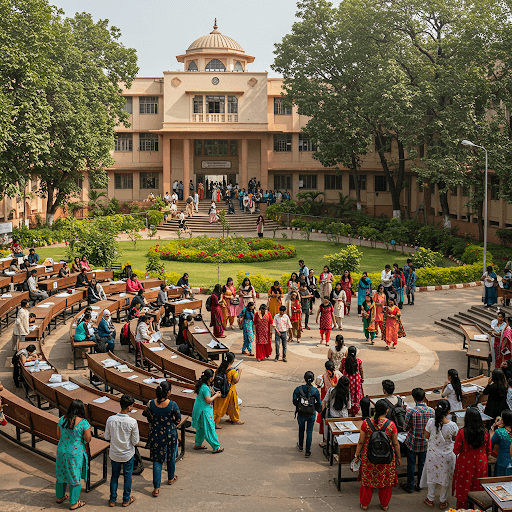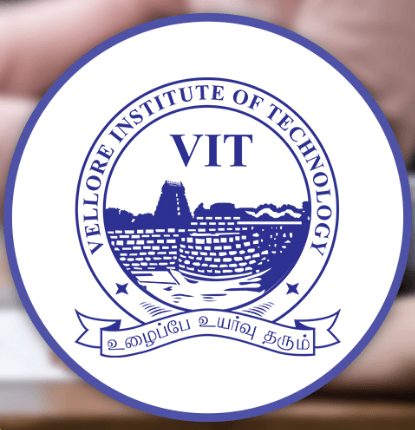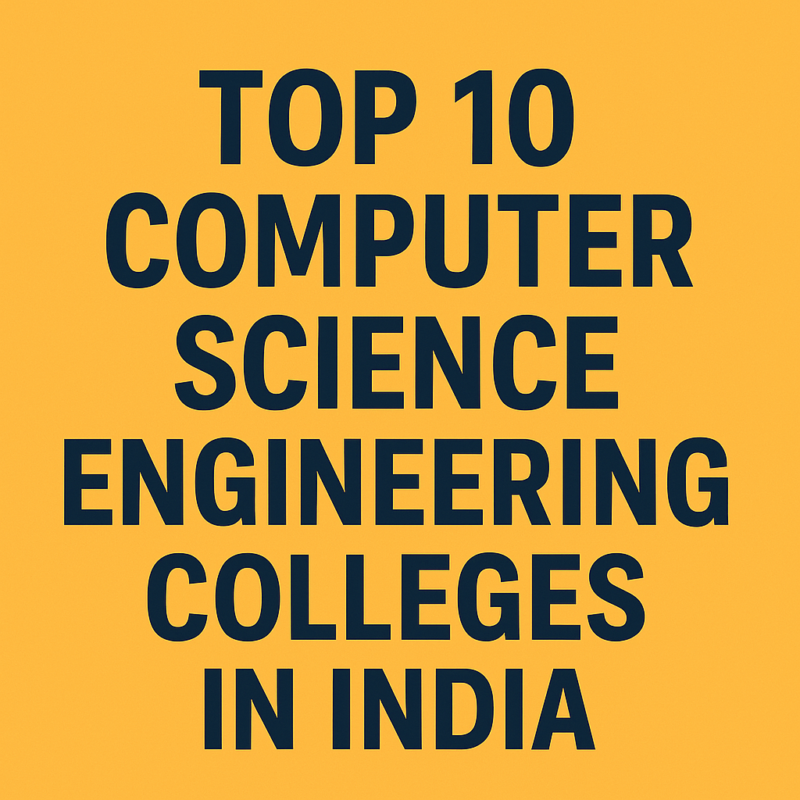
1. Introduction: Fueling Innovation – Choosing the Right Engineering College in India
Through the conception and development of new technologies and creative solutions to difficult problems, engineers play a critical role in advancing innovation and technological advancement, ultimately improving society. Engineering’s innate ability to solve problems gives graduates a broad range of skills that are highly sought after in many different industries. Choosing an engineering college is therefore about starting a life-changing journey that will mold a person’s ability to innovate and contribute to the technological future, not just about earning a degree. For prospective Indian innovators, this report offers a thorough guide to the important aspects to take into account when selecting an engineering school that will best support their goals and potential.
2. Decoding Quality: The Importance of Engineering College Accreditations (AICTE, NBA, NAAC)
In the field of higher education, accreditation is an essential tool for guaranteeing quality and upholding standards. It is a procedure by which impartial organizations assess colleges and universities to verify that they fulfill set academic standards, thereby confirming the caliber and legitimacy of the degrees they award. The National Board of Accreditation (NBA), the National Assessment and Accreditation Council (NAAC), and the All India Council for Technical Education (AICTE) are the three main accrediting organizations in India that have a major impact on the engineering education sector.
Instead of evaluating the entire institution, the NBA, on the other hand, concentrates on accrediting individual programs within technical disciplines like engineering, computer applications, pharmacy, and management. When an engineering program is NBA accredited, it means that it has passed a rigorous evaluation by subject-matter experts and satisfies strict quality standards, giving students confidence in the program’s academic rigor and industry relevance. OBE, a pedagogical approach that assesses students based on the knowledge, skills, and attitudes they acquire throughout the program to ensure they are well-prepared for the demands of the job market upon graduation, is a crucial component of NBA accreditation.
The Washington Accord, an international agreement that acknowledges the significant equivalency of accreditation systems in participating nations, is an important document that the NBA has signed. Because of this membership, graduates of NBA-accredited programs enjoy greater international recognition for their degrees, opening doors to professional careers and further education in other member countries.
The University Grants Commission (UGC) created the independent NAAC to evaluate and accredit institutions of higher learning based on a wide range of quality standards. The curriculum, teaching-learning procedures, research projects, infrastructure and learning resources, student support and advancement, governance and leadership, the institution’s core values and best practices, and more are all included in NAAC’s evaluation framework than in AICTE and NBA, which have a more technical focus.
An institution’s commitment to providing “Quality Education” is demonstrated by its NAAC accreditation, which also has several advantages, including helping the institution identify its SWOT analysis (strengths, weaknesses, opportunities, and threats), promoting a culture of continuous improvement in academic and administrative procedures, improving the employability of its graduates, and possibly increasing its eligibility for various grants and funding. With grades ranging from “C” to “A++,” NAAC’s grading system gives an overall picture of an institution’s quality and standards. The NAAC-granted accreditation usually lasts for five years.
3. The Cornerstones of Excellence: Evaluating Faculty Quality and Research Facilities
-
Experienced and research-active faculty shape students’ academic growth and innovation potential.
-
Ph.D. qualifications and industry experience ensure up-to-date, practical knowledge.
-
Research involvement offers students exposure to cutting-edge projects.
-
Strong mentorship fosters critical thinking and problem-solving skills.
-
A low student-to-faculty ratio enables personalized attention.
-
Diverse academic backgrounds enrich learning with multiple perspectives.
-
Evaluating faculty quality includes reviewing credentials, research output, industry experience, and student feedback.
Research Facilities: Driving Innovation
-
Modern laboratories, advanced equipment, and well-stocked libraries enable hands-on learning.
-
Funding for research supports faculty and students in technological advancements.
-
Industry-academia collaborations provide real-world exposure.
-
Colleges prioritizing research investments foster a strong culture of innovation.
-
Research quality can be assessed through lab infrastructure, NIRF rankings, patents, and publications.
4. Beyond the Classroom: Assessing Key Factors for Aspiring Innovators
5. The Pinnacles of Engineering Education: Top Government Institutes in India
-
Indian Institutes of Technology (IITs): Centers of Excellence India boasts a network of 23 Indian Institutes of Technology (IITs) strategically located across the country . These institutions, established as centers of excellence in engineering and technology, include both the older, more established IITs and a set of newer IITs that have been founded in recent years. The key strengths of IITs include their consistently high academic standards, rigorous and constantly updated curricula, highly qualified and experienced faculty members who are often leaders in their respective fields, a strong emphasis on cutting-edge research and innovation, state-of-the-art infrastructure encompassing advanced laboratories and comprehensive research facilities, and an unparalleled track record of top-tier placements in leading national and international corporations . Furthermore, IITs have cultivated powerful and influential alumni networks, with graduates occupying prominent leadership positions in various industries worldwide . These institutions also benefit from significant government funding, enabling them to maintain exceptional educational and research standards .
Insight: IITs consistently achieve top rankings in national assessments such as the NIRF and are globally recognized as premier institutions for engineering and technology education . While the older IITs have a long-standing reputation for excellence, the newer IITs are also rapidly progressing in rankings and developing robust academic and research programs, often with a focus on emerging technologies .
Chain of Thought: For aspiring innovators, the IITs represent a highly competitive yet incredibly rewarding educational environment. Their strong emphasis on fundamental research, fostering a culture of innovation, and maintaining rigorous academic standards make them an ideal choice for students who are driven to push the boundaries of engineering and contribute to technological advancements.
Specific Strengths of Top IITs:
- IIT Madras (Chennai): Holds the top rank in the NIRF 2024 Engineering category and is renowned for its strong focus on innovation, entrepreneurship, and robust collaborations with industry . The institute offers a diverse array of academic programs and houses numerous advanced research centers .
- IIT Delhi: Secured the second position in the NIRF 2024 Engineering rankings and benefits from its strategic location in the capital, providing students with access to major corporate hubs, governmental organizations, and leading research institutions . IIT Delhi is known for its interdisciplinary approach to learning, its distinguished faculty, and its excellent track record in placements .
- IIT Bombay (Mumbai): It ranks third in the NIRF 2024 Engineering rankings and is a leading institute in engineering and technology education with a vast and well-organized campus. IIT Bombay is renowned for its research activities, strong industry connections, and international recognition.
- IIT Kanpur: Ranked fourth in the NIRF 2024 Engineering rankings, IIT Kanpur offers students academic flexibility, a student-centric teaching approach, and an inspiring learning environment that encourages critical thinking. The institute also provides students with the opportunity to pursue dual majors and minors.
- IIT Kharagpur: The oldest of the IITs, established in 1951, ranked fifth in the NIRF 2024 Engineering rankings, and is known for its comprehensive curriculum, extensive research initiatives, and a sprawling campus equipped with state-of-the-art facilities. The institute offers a wide range of programs spanning engineering, management, law, and the sciences .
- IIT Roorkee: It ranks sixth in the NIRF 2024 Engineering rankings and is one of the oldest technical institutes in India, known for its strong academic foundation and diverse student community.
- IIT Guwahati: Ranked seventh in the NIRF 2024 Engineering rankings, established in 1994, and recognized for its focus on research-driven innovation and its picturesque campus. The institute has also made efforts to increase the enrollment of female students in its programs.
- IIT Hyderabad: Ranked eighth in the NIRF 2024 Engineering rankings, established in 2008, and known for its modern and attractive campus, strong career prospects in the technology sector, and recent notable achievements in research.
- IIT Gandhinagar: Ranked 18 in the NIRF 2024 Engineering rankings, IIT Gandhinagar is distinguished by its interdisciplinary programs, emphasis on creative learning methodologies, and various initiatives in leadership development and sustainability.
- IIT Indore: Ranked 16 in the NIRF 2024 Engineering rankings, this newer IIT is gaining increasing recognition for its growing academic programs and research environment .
-
National Institutes of Technology (NITs): Regional Powerhouses The National Institutes of Technology (NITs) form a network of 31 centrally funded technical institutions located across India, each serving as a premier center for engineering and technology education within its respective region .
Key Strengths: NITs offer a well-structured curriculum, experienced and dedicated faculty, and generally maintain strong placement records, particularly within industries prevalent in their region . Many NITs also boast robust alumni networks that are often influential within their respective states. Furthermore, the tuition fees at NITs are typically more affordable compared to those at the IITs.
Insight: NITs provide a high-quality engineering education and are a popular choice for students who qualify through the JEE Main examination. The top NITs are highly competitive and consistently rank among the best engineering colleges in India . Newer NITs are also making significant strides in improving their academic standards and overall rankings .
Chain of Thought: For aspiring innovators who may prefer a regional focus or who have performed well in JEE Main, NITs offer an excellent pathway to quality engineering education with strong career prospects.
Specific Strengths of Top NITs:
- NIT Trichy (Tiruchirappalli): Ranked 9 in NIRF 2024, consistently holds the top position among all NITs and is highly regarded for its rigorous academic programs and exceptional placement record .
- NIT Surathkal (Karnataka): Ranked 17 in NIRF 2024, located in a picturesque coastal setting, NIT Surathkal is known for its strong academic environment, robust collaborations with industry, and a vibrant and engaging campus life .
- NIT Rourkela (Odisha): Ranked 19 in NIRF 2024, one of the oldest NITs in India, NIT Rourkela emphasizes interdisciplinary learning, fosters a strong research culture, and promotes entrepreneurship among its students .
- NIT Warangal (Telangana): Ranked 21 in NIRF 2024, NIT Warangal is a premier engineering institution renowned for its strong emphasis on research and innovation, and it consistently achieves impressive placement statistics for its graduates.
- NIT Calicut (Kerala): Ranked 25 in NIRF 2024, NIT Calicut is known for its strong academic foundation, highly qualified faculty, and a dynamic student community. Its Department of Architecture has achieved national recognition, ranking among the top in the country.
-
Indian Institutes of Information Technology (IIITs): Focused on IT and Innovation The Indian Institutes of Information Technology (IIITs) are a network of 26 institutes established across India, primarily focused on providing high-quality education and research in information technology and related fields . Among these, five have been granted the status of Institutes of National Importance, while the remaining 21 operate under a Public-Private Partnership (PPP) model .
Key Strengths: IIITs are distinguished by their specialized focus on information technology and computer science engineering, which allows them to develop strong industry-oriented programs and cultivate close relationships with leading technology companies . They often have a significant emphasis on research in cutting-edge technologies and provide excellent placement opportunities for their graduates in the IT sector .
Insight: IIITs are particularly appealing to aspiring innovators who are passionate about pursuing careers in the IT and software development industries. Several IIITs, notably IIIT Hyderabad and IIIT Bangalore, have consistently achieved high rankings and are often considered on par with, or even preferred over, some of the older IITs for programs specifically in computer science .
Chain of Thought: For students with a clear inclination towards the IT domain and a drive for innovation within this rapidly evolving sector, IIITs offer a specialized and highly relevant educational experience that is strongly aligned with industry demands.
Specific Strengths of Top IIITs:
- IIIT Hyderabad: Ranked among the top IIITs (NIRF Rank 62 in Engineering 2024), IIIT Hyderabad is known for its strong research culture, a flexible curriculum that allows students to tailor their studies to their interests, and robust connections with the IT industry . It provides ample research opportunities, even for undergraduate students.
- IIIT Bangalore: Also ranked among the top IIITs (NIRF Rank 81 in Engineering 2024), IIIT Bangalore is distinguished by its world-class faculty, a vibrant and influential alumni community, a strong emphasis on cutting-edge research, and close collaborations with the IT industry.
- IIIT Delhi: Ranked among the leading IIITs (NIRF Rank 85 in Engineering 2024), IIIT Delhi benefits from its location in the capital, providing excellent access to corporate and research opportunities. It is known for its strong placement record and a significant focus on research and innovation across various IT-related domains.
- IIIT Allahabad: Consistently ranked among the top IIITs (NIRF Rank 93 in Engineering 2024), IIIT Allahabad offers a range of undergraduate, postgraduate, and doctoral programs primarily in information technology and related fields, and it maintains a good track record in student placements.
- ABV-IIITM Gwalior: A well-regarded IIIT that offers undergraduate, postgraduate, and doctoral programs in various fields, including management and information technology.
-
Other Prestigious Government Engineering Institutes Beyond the IITs, NITs, and IIITs, several other government-funded institutions in India hold significant prestige and offer excellent engineering education.
- Indian Institute of Science (IISc) Bangalore: Ranked among the top academic institutions in India (NIRF Rank 4 in Overall 2024), IISc Bangalore is primarily a research-intensive university with a strong focus on science, engineering, and technology. It offers postgraduate and doctoral programs and is renowned for its cutting-edge research across various engineering disciplines.
- Jadavpur University (Kolkata): Ranked 12 in Engineering by NIRF 2024, Jadavpur University is known for providing high-quality education at an affordable cost. It has a strong Faculty of Engineering and Technology and a good placement record, particularly in core engineering sectors.
- Delhi Technological University (DTU) (New Delhi): Ranked 27 in Engineering by NIRF 2024, DTU has a long-standing history of excellence in engineering education, dating back to its establishment as Delhi Polytechnic in 1941 . It boasts a strong alumni network and offers a diverse range of undergraduate and postgraduate programs in engineering and technology.
- College of Engineering, Guindy (CEG), Anna University (Chennai): As one of the oldest engineering colleges in India, CEG, part of Anna University (which is ranked 14 in Engineering by NIRF 2024), has a rich legacy of producing distinguished engineers and technologists. It offers a wide spectrum of engineering programs and maintains strong academic standards.
6. Leading the Charge in the Private Sector: Top Private Engineering Colleges in India
-
Top Private Engineering Colleges (Based on NIRF Ranking 2024):
- Vellore Institute of Technology (VIT), Vellore (Rank 11)
- S.R.M. Institute of Science and Technology (SRMIST), Chennai (Rank 13) .
- Birla Institute of Technology and Science (BITS), Pilani (Rank 20) .
- Amrita Vishwa Vidyapeetham (Rank 23) .
- Siksha ‘O’ Anusandhan (SOA), Bhubaneswar (Rank 26) .
- Thapar Institute of Engineering and Technology (Rank 29) .
- Amity University, Noida (Rank 30) .
- Chandigarh University (Rank 32) .
- Sri Sivasubramaniya Nadar College of Engineering (Rank 46) .
- Manipal Institute of Technology (Rank 56) .
-
Distinguishing Features:
- VIT Vellore: Known for its eco-friendly campus, student-centered approach, and strong emphasis on industry-focused programs and global collaborations .
- BITS Pilani: Renowned for its flexible academic structure, strong industry linkages providing excellent internship and placement opportunities, and a rigorous merit-based admission process .
- SRMIST: Offers a wide spectrum of programs with a strong focus on research, international collaborations, and a commendable placement record across various industries .
- Amrita Vishwa Vidyapeetham: Distinguished by its strong research orientation, extensive collaborations with leading international universities, and a commitment to imparting value-based education with a focus on societal impact .
- Chandigarh University: Holds the distinction of being the first private university in India to receive ABET accreditation for all its engineering and CSE programs, signifying adherence to global quality standards. The university also emphasizes strong industry partnerships and fosters a culture of research and innovation .
- Thapar Institute: Recognized for its robust academic programs that have earned accreditation from both NAAC and ABET. The institute actively promotes research and maintains strong linkages with the industry to ensure its curriculum remains relevant .
- Amity University: A leading research-driven private university in India with a vast network of campuses. Amity is known for its industry-oriented teaching methodologies, state-of-the-art infrastructure, and strong corporate interactions that facilitate excellent placement opportunities for its students .
- Manipal Institute of Technology: One of the earliest self-financing engineering colleges in India, MIT Manipal has a proactive placement cell and a strong global alumni network that includes many industry luminaries. The institute maintains strong partnerships with various industries for collaborative projects and internships .
7. The Future is Bright: Emerging Engineering Colleges Gaining Recognition
-
Emerging Engineering Colleges:
- Newer IITs: IIT Hyderabad, IIT Gandhinagar, IIT Patna, IIT Ropar, IIT Indore, IIT Mandi, IIT Bhubaneswar, IIT Jodhpur, IIT Tirupati, IIT Palakkad, IIT Bhilai, IIT Goa, IIT Jammu, IIT Dharwad . These IITs, established in recent years, are rapidly developing their infrastructure, attracting talented faculty, and establishing strong research programs, often with a focus on interdisciplinary studies and emerging technologies .
- Newer IIITs: IIIT Lucknow, IIIT Pune, IIIT Guwahati, IIIT Kota, IIIT Sri City, IIIT Vadodara, IIIT Nagpur, IIIT Kalyani, IIIT Dharwad, IIIT Bhagalpur, IIIT Bhopal, IIIT Kottayam, IIIT Ranchi, IIIT Una, IIIT Surat, IIIT Manipur, IIITDM Kurnool, IIIT Tiruchirapalli, IIIT Sonepat, IIIT Agartala, IIIT Karnataka . Primarily focused on information technology and computer science, these institutes are building strong connections with the IT industry and emphasizing research in cutting-edge areas .
- Other Private Universities: Bennett University, SRM University AP, Shiv Nadar University, KIIT University, Lovely Professional University (LPU), Chandigarh University, UPES Dehradun, Mahindra University, RV University, PES University . These private universities, many established relatively recently, are often characterized by their flexible curricula, industry-focused programs designed to meet current market demands, and modern infrastructure.
-
Distinguishing Features:
- Newer IITs like IIT Hyderabad and IIT Gandhinagar are gaining recognition for their strong emphasis on research, fostering a culture of innovation, and promoting interdisciplinary programs. They are actively establishing state-of-the-art research centers and engaging in collaborations across various fields .
- Newer IIITs, such as IIIT Bangalore and IIIT Hyderabad, are distinguished by their focus on providing research opportunities even to undergraduate students, their adoption of flexible and modern curricula that are regularly updated to reflect industry trends, and their strong collaborations with the IT industry, particularly in high-demand areas like artificial intelligence, data science, and cybersecurity .
- Private universities like Chandigarh University are emerging as noteworthy institutions, exemplified by their achievement as the first private university in India to secure ABET accreditation for all their engineering and CSE programs, demonstrating a commitment to meeting globally recognized standards of technical education. These universities often prioritize industry-collaborated programs and actively foster a culture of research and entrepreneurship among their students .
8. Specialized Pathways to Innovation: Top Colleges by Engineering Discipline
- Computer Science and Engineering:
- Top Colleges: IIT Madras, IIT Delhi, IIT Bombay, IIT Kanpur, IIT Kharagpur, IIT Hyderabad, IIT Guwahati, IIT Roorkee, IIT BHU Varanasi, IIT Indore, IIT Gandhinagar, IIIT Hyderabad, IIIT Bangalore, IIIT Delhi, IIIT Allahabad, IIIT Gwalior, NIT Trichy, NIT Surathkal, NIT Warangal, NIT Calicut, NIT Rourkela, BITS Pilani, DTU, IISc Bangalore, Vellore Institute of Technology (VIT) .
- Mechanical Engineering:
- Top Colleges: IIT Madras, IIT Delhi, IIT Bombay, IIT Kanpur, IIT Kharagpur, IIT Roorkee, IIT Guwahati, NIT Trichy, NIT Surathkal, NIT Warangal, NIT Rourkela, NIT Calicut, BITS Pilani, IISc Bangalore, Vellore Institute of Technology (VIT), SRMIST, Thapar Institute .
- Civil Engineering:
- Top Colleges: IIT Madras, IIT Delhi, IIT Bombay, IIT Kanpur, IIT Roorkee, IIT Kharagpur, IIT Guwahati, NIT Trichy, NIT Surathkal, NIT Warangal, NIT Rourkela, NIT Calicut, IISc Bangalore, DTU, VIT Vellore, Anna University, Thapar Institute .
- Electrical Engineering:
- Top Colleges: IIT Madras, IIT Delhi, IIT Bombay, IIT Kanpur, IIT Kharagpur, IIT Roorkee, IIT Guwahati, IIT Hyderabad, NIT Trichy, NIT Surathkal, NIT Warangal, NIT Rourkela, NIT Calicut, NIT Nagpur, IISc Bangalore, VIT Vellore .
- Aerospace Engineering:
- Top Colleges: IIT Bombay, IIT Madras, IIT Kharagpur, IIT Kanpur, IIT Delhi, IIT Hyderabad, IIT Roorkee, IIST Thiruvananthapuram, Hindustan Institute of Technology and Science, Amity University, VIT Vellore, SRMIST, Manipal Institute of Technology .
- Biotechnology Engineering:
- Top Colleges: IIT Delhi, IIT Kharagpur, IIT Roorkee, IIT Hyderabad, IIT BHU Varanasi, VIT Vellore, DTU, NIT Rourkela, IIIT Hyderabad (Bioinformatics), Amity University, SRMIST, Thapar Institute .
9. Navigating the Gates: Entrance Exams and Admission Procedures
- Admission to the premier engineering colleges in India is primarily conducted through a set of highly competitive national and state-level entrance examinations.
- JEE Advanced: This examination serves as the sole gateway to the prestigious Indian Institutes of Technology (IITs). Eligibility to appear for JEE Advanced typically requires qualifying through JEE Main and securing a sufficiently high rank. The admission process involves online registration, appearing for two mandatory papers, and subsequently participating in the Joint Seat Allocation Authority (JoSAA) counseling process, where seats are allotted based on the candidate’s rank and preferences .
- JEE Main: This examination acts as the primary qualifying test for admission to the National Institutes of Technology (NITs), the Indian Institutes of Information Technology (IIITs), and numerous other engineering colleges, both government-funded and private. To be eligible for JEE Main, candidates generally need to have passed their Class 12 examination with Physics, Chemistry, and Mathematics as compulsory subjects. The admission process includes online application, appearing for the examination (Paper 1 is for B.Tech admissions), and then participating in the JoSAA or Central Seat Allocation Board (CSAB) counseling for seat allotment .
- State CETs (Common Entrance Tests): Several states across India conduct their own Common Entrance Tests (CETs) to facilitate admissions to engineering colleges located within their jurisdiction. These tests serve as the primary admission route for many state government-run and private engineering colleges. Notable examples include the Maharashtra Common Entrance Test (MHT CET), the Karnataka Common Entrance Test (KCET), and the Tamil Nadu Engineering Admissions (TNEA). The specific eligibility criteria and admission procedures for each state’s CET can vary, so aspiring students need to check the respective state’s official admission guidelines .
- Private University Exams: Many private universities in India conduct their own independent entrance examinations for admission to their engineering programs. These university-specific exams often assess candidates on their aptitude in Physics, Chemistry, and Mathematics, as well as their general English and logical reasoning skills. Prominent examples of such private university entrance exams include the Vellore Institute of Technology Engineering Entrance Exam (VITEEE), the Birla Institute of Technology and Science Admission Test (BITSAT), and the SRM Joint Engineering Entrance Examination (SRMJEEE). The eligibility criteria and the detailed admission processes for these exams are determined by the individual universities .
- The general admission procedures for most engineering colleges involve an initial step of online application, either through the official website of the exam conducting body (for national and state-level exams) or directly through the website of the individual college (for private university exams) . Following the application, candidates are required to appear for the respective entrance examination. Based on the scores obtained in the exam, eligible candidates are then called for a counseling process. This counseling typically involves registering preferences for colleges and branches, followed by seat allotment based on the candidate’s rank, preferences, and the availability of seats .
10. Empowering Dreams: Scholarships and Financial Aid Options for Engineering Students
- For aspiring engineering students in India who may require financial assistance to pursue their educational goals, a wide array of scholarships and financial aid options are available from various sources.
- Government Schemes: The central government and various state governments in India offer numerous scholarship schemes specifically for students pursuing technical education, including engineering. Additionally, regulatory bodies such as the All India Council for Technical Education (AICTE) and the University Grants Commission (UGC) administer a range of scholarship and financial assistance programs aimed at supporting students in technical fields . Furthermore, students belonging to specific categories, such as Scheduled Castes (SC), Scheduled Tribes (ST), Other Backward Classes (OBC), and Economically Weaker Sections (EWS), may be eligible for special scholarships and financial aid packages designed to promote inclusivity and access to higher education.
- Private Scholarships: A multitude of private organizations, charitable trusts, and philanthropic foundations also provide scholarships to meritorious and financially disadvantaged engineering students in India. These scholarships often have specific eligibility criteria that may be based on academic performance, the student’s financial background, or their chosen engineering discipline. In some cases, alumni networks of engineering colleges also offer scholarships to support current students, fostering a culture of giving back and investing in future generations .
-
College-Specific Assistance: Many engineering colleges across India, including the prestigious Indian Institutes of Technology (IITs), National Institutes of Technology (NITs), Indian Institutes of Information Technology (IIITs), and various private universities, offer their own unique sets of scholarships and financial aid options to their students . These may include merit-based scholarships awarded to students who achieve high ranks in entrance examinations or maintain excellent academic records, need-based scholarships for students who come from economically weaker backgrounds, and provisions for fee waivers or concessions for particularly deserving candidates. Some institutions also facilitate access to educational loans from banks and may offer installment payment options to ease the financial burden on students and their families.
- Insight: Aspiring innovators should proactively explore the specific scholarship and financial aid opportunities offered by the engineering colleges that align with their academic and career aspirations. It is crucial to carefully review the eligibility criteria, application procedures, and deadlines for each scholarship. The official websites of the respective colleges and the AICTE/UGC portals serve as valuable resources for obtaining detailed information on the various forms of financial assistance available to engineering students in India.
11. The Road Ahead: Placement Trends and Career Opportunities for Engineering Graduates
-
The placement trends and career opportunities available to engineering graduates from top Indian colleges are subject to the ever-evolving demands of the technology and industrial sectors . A diverse range of companies actively recruit engineering graduates from these institutions, spanning sectors such as information technology (including giants like TCS, Wipro, Infosys, Google, Microsoft, and Amazon), core engineering industries (such as Tata Motors, L&T, and Bosch), management consulting (with firms like McKinsey and Ernst & Young), and the finance industry (including companies like Goldman Sachs and JP Morgan).
Insight: While the average annual salary for engineers in India can range from approximately Rs. 4 lakhs for entry-level positions to Rs. 21 lakhs for experienced professionals, with a general average of around Rs. 8 lakhs , it is important to recognize that salary packages can vary significantly based on factors such as the specific engineering college attended, the chosen specialization, and the individual skills and competencies of the graduate .Premier institutions like the IITs and top-tier NITs often report considerably higher average and highest salary packages offered to their graduating students. However, it is crucial to acknowledge the existing skills gap in the broader pool of engineering graduates, with a significant percentage lacking the specific skills and expertise that are currently in high demand in the rapidly evolving job market, particularly in emerging fields such as artificial intelligence and other advanced technologies.
Chain of Thought: Aspiring innovators should strategically target engineering colleges that have a proven track record of successful placements in their desired field of specialization and should proactively focus on developing skills in cutting-edge and emerging technologies to significantly enhance their future career prospects and earning potential.
| College Name | NIRF Ranking 2024 | Average Placement Package (INR LPA) | Highest Placement Package (INR LPA) | Top Recruiting Sectors/Companies |
|---|---|---|---|---|
| IIT Madras | 1 | ₹22 | ₹1.98 Cr | IT, Consulting, Core Engineering, Finance |
| IIT Delhi | 2 | ₹36.9 | ₹2 Cr | IT, Consulting, Finance, E-commerce |
| IIT Bombay | 3 | ₹23.5 | ₹1 Cr | IT, Consulting, Finance, Manufacturing |
| IIT Kanpur | 4 | ₹26.27 | ₹1.9 Cr | IT, Consulting, Finance, Core Engineering |
| IIT Kharagpur | 5 | ₹22.13 | ₹2.14 Cr | IT, Consulting, Core Engineering, Analytics |
| IIT Roorkee | 6 | ₹18.3 | ₹2.05 Cr | IT, Consulting, Core Engineering, EdTech |
| IIT Guwahati | 7 | ₹25.75 | ₹2.4 Cr | IT, Finance, E-commerce, Analytics |
| IIT Hyderabad | 8 | ₹26.51 | ₹1.05 Cr | IT, E-commerce, Product Development |
| NIT Trichy | 9 | ₹15.76 | ₹52.89 | IT, Core Engineering, Consulting, Finance |
| IIIT Hyderabad | 62 | ₹26.34 | ₹105 | IT, Product Development, Research |
| BITS Pilani | 20 | ₹30.37 | ₹60.75 | IT, Consulting, Finance, Analytics |
| VIT Vellore | 11 | ₹9.23 | ₹1.02 Cr | IT, Core Engineering, E-commerce, Consulting |
| SRMIST Chennai | 13 | ₹7.19 | ₹52 | IT, Core Engineering, Healthcare |
| Amrita Vishwa Vidyapeetham | 23 | ₹7.3 | ₹56.95 | IT, Consulting, E-commerce, Core Engineering |
| Chandigarh University | 32 | ₹9.54 | ₹1.7 Cr | IT, Consulting, E-commerce, EdTech |
| Thapar Institute | 29 | ₹11.9 | ₹55.75 | IT, Analytics, Consulting, Core Engineering |
| Manipal Institute of Technology | 56 | ₹8.55 | ₹54.75 | IT, Core Engineering, Finance, Consulting |
Note: Placement data is for the graduating batch of 2023-24 and may vary. Rankings are based on NIRF 2024 for Engineering category, except for IIIT Hyderabad which is based on NIRF 2023 (as 2024 data was not available specifically for engineering ranking of IIITs).
12. Bridging Academia and Industry: The Importance of Internships and Exposure
- Internships and practical industry exposure are increasingly recognized as essential components of a comprehensive engineering education in India . These experiences provide students with invaluable opportunities to apply the theoretical knowledge gained in the classroom to real-world engineering challenges and to develop a deeper understanding of the professional environment . By participating in internships, students can gain firsthand insights into current industry trends, understand the practical challenges faced by engineers in the field, and acquire essential technical and soft skills that are highly valued by employers . This practical engagement effectively bridges the gap between the academic curriculum and the actual expectations of the workplace, thereby making engineering graduates more readily employable . Many companies actively collaborate with academic institutions to offer internships to students, providing them with a platform to work on real-world projects and gain meaningful industry experience . In some instances, these internships can even lead to offers of full-time employment upon graduation, providing a significant advantage to students as they embark on their professional careers . For aspiring innovators, internships in companies that are known for their innovative work or within research-oriented organizations can be particularly beneficial, offering them a chance to contribute to cutting-edge projects, receive guidance from experienced professionals, and further cultivate their entrepreneurial and problem-solving abilities. Engineering colleges that have established strong collaborations with industry leaders are more likely to offer well-structured and high-quality internship programs, providing students with access to leading organizations and a greater chance of being absorbed into these companies upon graduation . Therefore, aspiring innovators should prioritize colleges that have a strong track record of facilitating meaningful internship opportunities in their fields of interest.
13. The Evolving Landscape: Future Trends in Engineering Education in India
-
Engineering education in India is in a state of continuous evolution, driven by the rapid advancements in technology and the emergence of new industries . Several key trends are shaping the future of engineering education, reflecting the changing demands of the workforce and the global technological landscape. One significant trend is the increasing emphasis on interdisciplinary learning, which involves integrating core engineering principles with knowledge and skills from other fields, such as artificial intelligence (AI), machine learning, data science, robotics, and renewable energy . Experiential learning, which focuses on hands-on instruction, project-based learning, and the application of theoretical concepts to real-world scenarios, is also gaining prominence as an effective pedagogical approach . Furthermore, there is a growing recognition of the critical importance of non-technical skills, often referred to as soft skills, including communication, teamwork, leadership, and problem-solving abilities, in preparing engineers to excel in today’s complex and collaborative professional environments . Additionally, fostering an entrepreneurial mindset among students and providing them with ample opportunities for innovation and research are key trends that are being increasingly integrated into engineering education . The development of industry-specific programs and curricula, often in close collaboration with industry experts, ensures that students acquire the most relevant and up-to-date knowledge and skills that are directly applicable to the demands of the current job market . Finally, the growing significance of global collaborations and the increasing opportunities for international exposure are shaping engineering education to prepare graduates for a workforce that is increasingly interconnected and global in nature .
Insight: These evolving trends in engineering education have significant implications for aspiring innovators as they make decisions about which college to attend. It is increasingly important for these students to seek out institutions that not only provide a strong foundational understanding of core engineering principles but also offer specialized programs in emerging and high-growth fields. Aspiring innovators should look for colleges that actively promote interdisciplinary learning opportunities, provide ample avenues for hands-on practical experience and research involvement, and place a strong emphasis on the development of both technical expertise and essential soft skills. Choosing a college that is proactive in adapting to these future trends will ultimately equip aspiring innovators with the diverse skillset and forward-thinking perspective necessary to thrive in the dynamic and rapidly changing landscape of engineering.
14. Conclusion: Making the Informed Choice for an Innovative Future
Selecting the right engineering college in India is a pivotal decision that holds the potential to significantly shape the academic trajectory and future career prospects of aspiring innovators. This report has underscored the multitude of critical factors that should be carefully considered during this important decision-making process. These factors include the significance of college accreditations from bodies like AICTE, NBA, and NAAC, which serve as indicators of quality and standards; the expertise and research engagement of the faculty, who play a crucial role in imparting knowledge and inspiring innovation; the availability and quality of research facilities, which provide the necessary infrastructure for hands-on learning and experimentation; the college’s placement records and the career opportunities it facilitates for its graduates; the strength and relevance of its collaborations with industry, which offer practical exposure and real-world insights; the overall infrastructure and the quality of campus life, which contribute to a conducive and enriching learning environment; the presence and activity of a robust alumni network, which can provide invaluable guidance and connections; and the opportunities for global exposure, which are increasingly important in today’s interconnected world.
Aspiring innovators are encouraged to meticulously research and thoroughly evaluate engineering colleges based on these multifaceted criteria, ensuring that their final choice aligns closely with their individual interests, their specific career aspirations, and the continuously evolving landscape of engineering and technology. It is important to remember that while college rankings can provide a useful overview, the decision should ultimately be based on a comprehensive assessment of all the factors that contribute to a high-quality and innovation-focused engineering education. By making a well-informed choice, aspiring innovators can lay a solid foundation for a successful and impactful future in the dynamic field of engineering.
Latest Blog Post

Branches of Engineering: A Comprehensive Overview
24 Feb, 2024
Top Engineering Colleges in Madhya Pradesh
24 Feb, 2024


